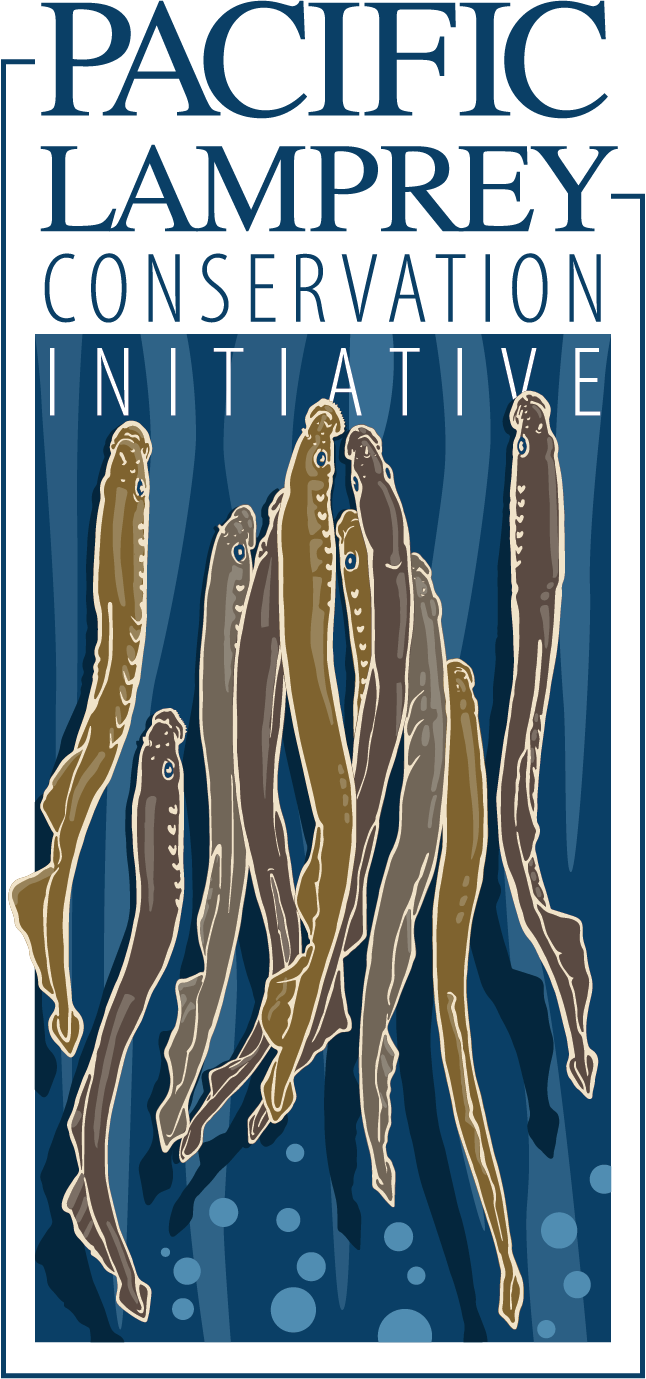About PLCI
Freshwaters Illustrated
Pacific Lamprey in Decline
Pacific Lamprey (Entosphenus tridentatus) belong to a group of ancient fishes that have been around for ~400 million years and inhabit freshwater and ocean habitats from Southern California through the Pacific Northwest and Alaska, across the Bering Sea to Japan. Pacific Lamprey are a native species that historically returned to rivers and streams to spawn in large numbers. Current populations have declined in abundance and are impacted by misperceptions and lack of awareness. Threats to Pacific Lamprey occur in much of the species’ range and include artificial obstructions that restrict access to spawning and rearing habitats, reduced flows and dewatering of streams, stream and floodplain degradation, degraded water quality, and changing marine and climate conditions.
Our Ancient Friend
Pacific Lamprey are vitally important to Indigenous people throughout their range and play key cultural and ecological roles in these communities and ecosystems. Long considered an important source of food for tribal communities – Pacific Lamprey are prized for their rich fatty meat and appreciated as a medicinal and nourishing food.
Despite their cultural importance to tribal communities throughout its range, unfortunately, Pacific Lamprey were often considered “junk fish” by non-tribal fisherman, and subjected to deliberate poisonings and removal. Tribes have been leaders in sounding the alarm as reductions in the abundance and range of Pacific Lamprey accelerated, and have helped initiate collaborative efforts to restore Pacific Lamprey populations and educate the public of their importance. Now in addition to being a species of immense cultural significance for Native American tribes, Pacific Lamprey are a tribal trust species for the USFWS, and a species of concern for many states.
Click here for the latest Pacific Lamprey distribution map.
Freshwaters Illustrated
Produced in partnership with the Columbia River Inter-Tribal Fish Commission, and in cooperation with the U.S. Fish & Wildlife Service.
A Collaborative Solution
In 2004, a petition to list Pacific Lamprey under the Endangered Species Act (ESA) was deemed “not warranted” by the U.S. Fish & Wildlife Service (USFWS) due to a lack of information and defined distinct population segments. This decision and the cultural importance of Pacific Lampreys sparked a collaborative effort to restore this important species.
In 2007, an effort was initiated to conserve and restore Pacific Lamprey outside the ESA-listing process. The result was the formation of the Pacific Lamprey Conservation Initiative (PLCI) in 2008 – a diverse collaboration of Native American tribes, federal, state, municipal and local agencies, non-profits, and others working together to achieve long-term persistence of Pacific Lamprey and their habitats, and to support their traditional tribal uses across their historical range. There are three components to PLCI: the Pacific Lamprey Assessment, Pacific Lamprey Conservation Agreement, and Regional Implementation Plans.
Three Components of PLCI
Pacific Lamprey Assessment
Every five years partners evaluate Pacific Lamprey habitat condition, population demographics, distribution, and threats to characterize conservation risk across their historical range.
Conservation Agreement
First signed in 2012, as a voluntary commitment by partners to work collaboratively to reduce or eliminate threats to Pacific Lamprey.
Regional Implementation Plans
Developed by each of the 18 Regional Management Units (RMUs) spanning the Pacific Lamprey’s U.S. range to identify, prioritize, and implement key conservation actions.
Implementing the Initiative
Representatives from organizations from across the historical distribution of Pacific Lamprey and beyond make up the many committees, workgroups and Regional Management Units (RMUs) that lead and implement the conservation actions necessary to achieve long-term persistence and support the traditional tribal use of Pacific Lamprey.
Lamprey Technical Workgroup
A large, diverse, and active membership representing a variety of organizations from across PLCI's geographic range that serve as the Initiative's technical committee and consists of 11 subgroups.
Regional Management Units
Each of the 18 Regional Management Units (RUMs) are made up of local partners and stakeholders that collaborate to develop and implement Regional Implementation Plans (RIPs) that provide 3-5 year strategies for identifying projects and priorities to conserve and protect Pacific Lamprey in their region.
Conservation Team
The primary body supporting the implementation of the Conservation Agreement, made up of technical or management experts selected by the signatories and supporting entities.
Steering Committee
A subset of the Conservation Team that provides timeline guidance and oversight of the Conservation Team's responsibilities.
Policy Committee
High-ranking decision makers from the signatories and supporting entities. Provide visioning and guidance on long-term strategic planning, identification of funding sources, and outreach.
Pacific Lamprey Project Funding
Increased Need, Enthusiasm, & Opportunity
Since 2018, through a partnership with Bonneville Power Administration (BPA) and the Northwest Power and Conservation Council (NWPCC), PLCI has been able to provide approximately $300,000 annually towards lamprey projects in the Columbia River Basin. These projects have played a pivotal role in furthering PLCI’s mission, but this work is just the beginning and can only occur in this specific region.
Despite being officially recognized as a fish habitat partnership (FHP) by the National Fish Habitat Partnership (NFHP) in 2016, PLCI was not eligible to receive NFHP project funds until 2022. However, beginning in 2017 PLCI elected to use a portion of the NFHP stable operational support funding it began receiving as an FHP to support projects in regions beyond the Columbia River Basin to further our mission of achieving long-term persistence of Pacific Lamprey throughout their historical range along the west coast of the United States.
Even with a lack in dedicated funding to support projects outside the Columbia River Basin, interest and enthusiasm in Pacific Lamprey continue to grow rapidly, and now with the addition of NFHP project funds PLCI is excited to demonstrate the overwhelming need and opportunity for additional support for lamprey projects across the U.S. West Coast.
Occasionally, targeted funding opportunities are made available to to PLCI and its partners. Examples include the following:
©2022 Pacific Lamprey Conservation Initiative
